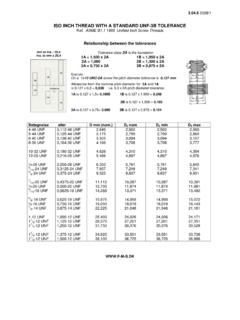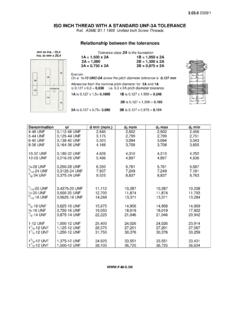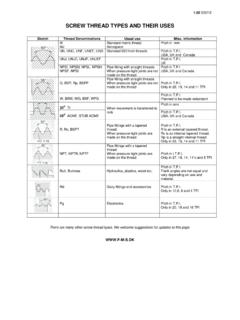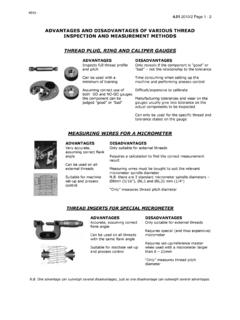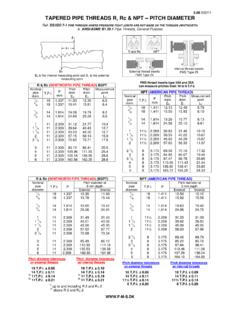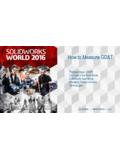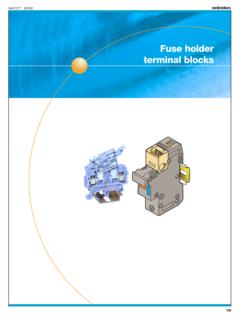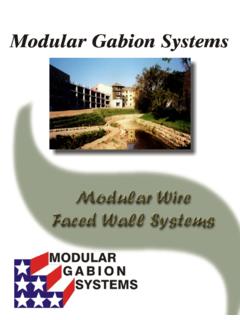Transcription of DIN862 Page 1 - 4
1 DIN862 Page 1 - 4 CALIPER ACCURACY SPECIFICATIONS AND CALIBRATION INFORMATION The information in this document applies to the caliper form types shown above. Conversion: mm to ins. = mm / (50mm = ins.) 1 m (0,001mm) ins. ~ ins. (30 m = ins.) The most internationally widely used caliper standard (DIN 862 Vernier calipers; requirements, testing) gives the following requirements (all in mm) for caliper measurement accuracy: A more comprehensive version of this table (and much more) can be found in DIN 862 Measurement length (mm) Accuracy limits G1) in m (0,001mm) Scale values: Vernier and Dial Digital 0,1 and 0,05 0,02 0,01 50 50 20 20 100 200 30 30 300 400 60 500 70 600 80 700 90 40 40 800 100 900 110 1000 120 1200 140 50 --- 1400 160 1600 180 60 1800 200 2000 220 G1) values should be increased by 20 m when measuring inside and depth measurements.
2 The parallelism of measuring faces shall be preserved after locking. DIN 862 is the standard used by most manufacturers as the referenced requirement and testing standard. As the above table is only a small portion of the actual standard, it is recommended that DIN 862 be read by anyone wishing all information. It is available in (at least) German and English. DIN 862 is identical to ISO 2012 Page 2 - 4 For those that wish to be reasonably sure of their caliper functionality and accuracy, the following three pieces of advice/information may be useful. Caliper Calibration Information For caliper form types 1A, 2A, B, D and E note that the reading is carried out by vernier, dial or digital display. While DIN 862 states requirements more than those that having direct influence on measurement accuracy (secondary requirements to form, material etc.)
3 , then only those requirements pertinent to measurement accuracy are dealt with here. DIN 862 does not have special requirements to repeatability. Two important factors having direct influence on measurement accuracy is the ability to establish a uniform measurement pressure and the caliper s measuring surfaces in relation to the reference (gauge blocks or ring gauges). Reading deviation is the difference between the caliper s actual measurement and the true value. In other words, the difference between the caliper reading and the reference standard used. Din 862 specifies requirements as to by how much the measurement deviation may vary. If measurements are carried out with different measurement force directions then there is an extra allowance. Measurement surfaces Reference ring gauge Knife shaped 5 mm 20 mm Rounded 30 mm The allowance for G (see table on page 1 - 4) for scale values 0,1 and 0,05mm is (20 + 1/10 mm) m.
4 The allowance for G (see table on page 1 - 4) for scale values 0,02 and 0,01mm is (22 + 1/50 mm) m. Requirements for external and internal measurement with measurement jaws of form types 1A, 2A, B, D and E are given in the table on page 1 - ?. These requirements are also applicable to form type B with the knife edged and rounded measurement surfaces. The allowances for G for internal and depth measurement apply when relevant. As mentioned for G1) in the table on page 1 - 4 this allowance also applies to depth measurement with the depth rod shown in form types 1A and 2A. In principle all caliper measuring surfaces (external, internal and depth) should be calibrated. However, as it is the same scale being read, then it is enough to calibrate this once. The scale is normally calibrated at several points with the jaws for external measurement. If there is more than one set of jaws for external measurement then the longest should be chosen.
5 The other measuring surfaces only need calibration at one or two points. The result is shown on the scale (or display) and the deviation to the reference be noted. The accuracy of the reading will depend on the quality and display principle. Recommended measurement steps Measurement point No. Max. measurement length (mm) 150 300 500 1 0 0 0 2 12,9 37,9 42,9 3 22,8 47,8 102,8 4 41,4 81,4 131,4 5 55,1 105,1 185,1 6 67,6 142,6 217,6 7 75 165 265 8 90,3 190,3 310,3 9 107,7 207,7 357,7 10 120,2 145,2 400,2 11 142,5 252,5 452,5 12 150 300 500 For external calibration measurement gauge blocks should be used. Three measurements, at the top of the jaws near to the caliper beam, the middle of the jaws and at the bottom of the jaws, will reveal any variation in jaw parallelism. A round reference gauge is also recommended for a complete calibration. Measurements should be carried out at various points over the entire caliper range.
6 For external calibration measurement ring gauges should be used. 5 and 20 mm are recommended. For depth calibration measurement gauge blocks should be used. The uncertainty of measurement using a caliper is due to several factors. The user s ability to maintain a uniform measurement pressure. The temperature at the calibration environment. The overall caliper condition. The sliding jaw too slack or too tight, measurement jaws nicked or marked etc. Page 3 - 4 Caliper Calibration Instruction All calipers have an identification number. If owning and calibrating two or more calipers it is always a good idea to make a calibration report for each individual caliper. How detailed this report should be depends on the purpose for which it will be used. Clean the caliper before calibration, especially the measuring surfaces. Move the sliding jaw 10 times thorough the entire measurement range.
7 The sliding jaw should move freely and without slack. The measuring surfaces, especially the knife edged, should be checked visually for wear and other forms of deformation. Check the condition of any scale. blurred lines etc. Acclimatize the caliper and the reference items to be used. External measurement calibration Choose the block gauges to be used so that they cover the entire measurement length at suitable distances so that the various digits are part of the individual measurement calibration. The table on page 2 - 4 is an example of possible nominal values depending on caliper length. Clean the gauge blocks and zero the caliper with the jaws closed. The measurement pressure used when calibrating should be kept as uniform as possible. For repeatability, choose for example a 50 mm gauge block and measure at three stages with the caliper jaws as shown.
8 Make sure the gauge block is squarely against the measurement jaws. Note the caliper measurement at each stage. Repeat each measurement five times and note each result. If the caliper has two external measuring surfaces calibrate both. Internal measurement calibration Chose the diameters of the gauge rings to be used. The diameters (or close to) recommended on page 2 - 4 are advisable but will depend on the calipers form type. Clean the gauge rings and zero the caliper after pushing the jaws together. Note the ring gauges diameter and measure as shown in the first figure. Repeat as shown in the second figure. Two results will be noted for the same gauge ring. Repeat the process with the second ring gauge. The same process should be used with calipers having rounded internal measurement jaws. One measurement should be enough. Depth measurement calibration Choose a gauge block.
9 25 mm. Clean the gauge block and the reference plane. Zero the caliper after pushing the jaws together. Place the caliper beam base on the gauge block and move the depth rod to the reference plane. The caliper must be at a right angle to the gauge block. Depth rod For all calibration measurement results the following formula applies: Deviation shown = the noted value minus the true value. Page 4 - 4 Caliper Check Instruction When checking a caliper before use check as many of the previously mentioned stages as deemed relevant or necessary. A caliper is an accurate measuring instrument when used correctly within the specified accuracy limitations. Summation A caliper should always have a specified reference to accuracy. For the majority of calipers DIN 862 is the one most often used. Buying a caliper (or any measuring instrument) without accuracy specifications being given is foolhardy at best.
10 Know what you are dealing with and it s limitations. Special calipers, and especially those have long or otherwise special legs may have a larger accuracy specification than that given in DIN 862. A new generation of digital calipers have displays showing measurement values of 0,005 and some showing 0,001mm. This does not mean they are this accurate, but will invariably have smaller than standard accuracy specifications given. Many calipers with a display of 0,005mm claim to be twice as accurate as specified in DIN 862. Is this claim correct? Check and find out it s easy to do. A good Rule of Thumb when buying a caliper, is to choose one with the name of the manufacturer on it. There is usually a reason why anonymous (and cheap) calipers are anonymous. As a uniform measurement pressure is often critical for an accurate result, there are caliper pressure devices on the market.

